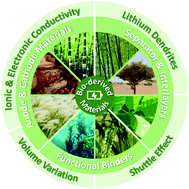Sustainable, non-toxic, and low-cost bio-derived materials (BDMs) have interesting structures, complex compositions, and unique functional groups and have been used as electrode materials, separators, interlayers, and binders in lithium-ion batteries (LIBs). More and more BDMs have been used to tackle the critical challenges of high theoretical capacity LIBs, low ionic and electronic conductivity for high-capacity active materials, the large volume expansion of lithium-conversion active materials (e.g., Si anode), the uncontrollable side reactions and lithium dendrites in the lithium metal anode, and the shuttle effect of lithium–sulfur like systems. In this work, we systematically review the preparation, mechanisms, and the applications of BDMs and summarize the role they play in resolving these challenges so that larger capacity, higher power density and longer cycle life of next-generation LIBs can be achieved in a green and sustainable manner.
